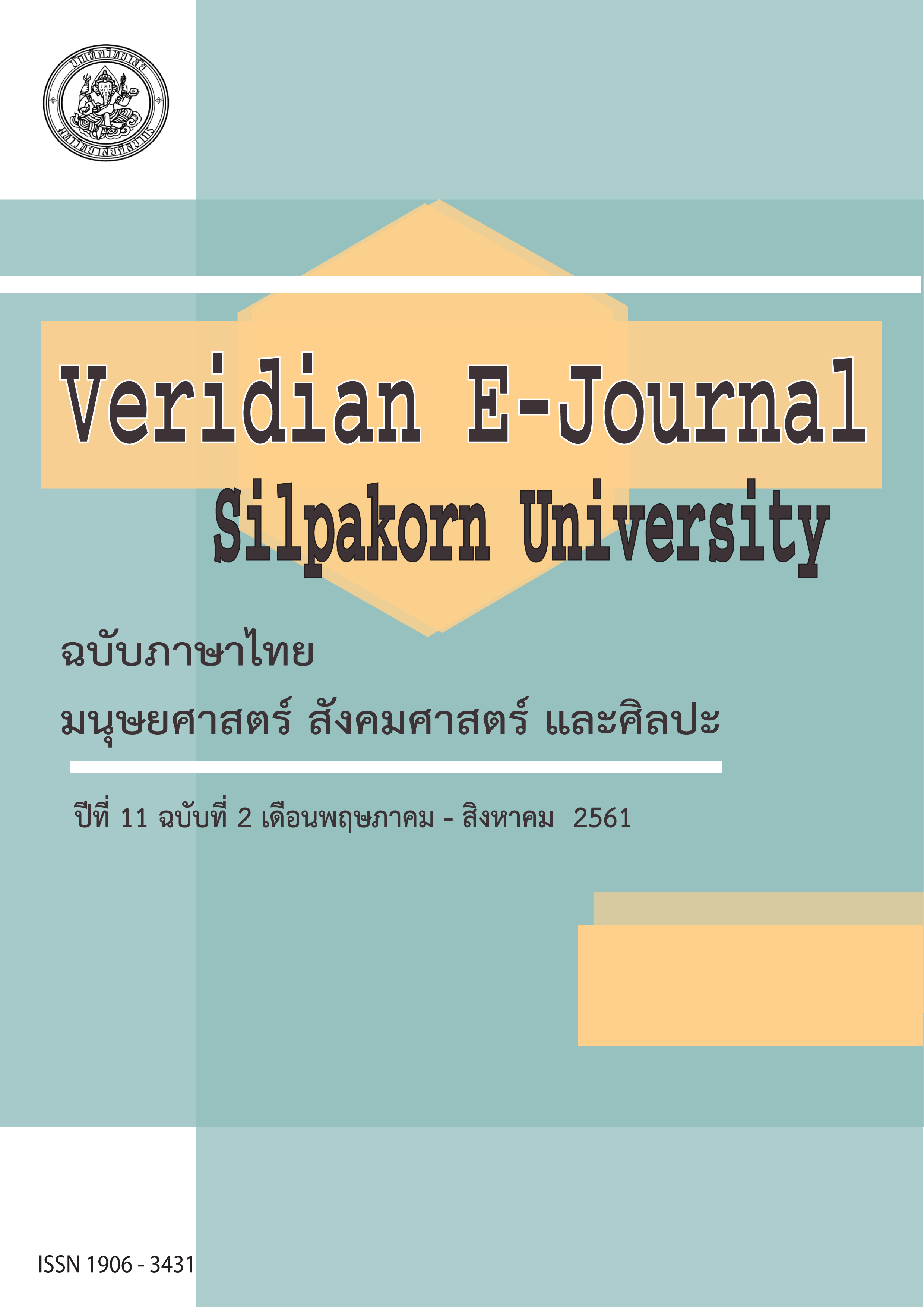รูปแบบความหลากหลายของการจัดกิจกรรมการท่องเที่ยววิถีชุมชนริมแม่น้ำแม่กลองอย่างสร้างสรรค์เพื่อรองรับนักท่องเที่ยวกลุ่มศักยภาพสูงของจังหวัดสมุทรสงคราม (The Diversity Model of Management on Creative Tourism Activities in Mae Klong River Community Area for -) The Diversity Model of Management on Creative Tourism Activities in Mae Klong River Community Area for Supporting High Potential Tourists of SamotSongkharm Province
Main Article Content
Abstract
การวิจัยครั้งนี้ เป็นการวิจัยและพัฒนา โดยวัตถุประสงค์การวิจัยเพื่อ 1) ศึกษาทัศนคติ ความพึงพอใจและแรงจูงใจของนักท่องเที่ยวที่มีศักยภาพสูงในการจัดกิจกรรมการท่องเที่ยววิถีชุมชนริมสายน้ำแม่กลองอย่างสร้างสรรค์ 2) ศึกษาศักยภาพและความพร้อมในการจัดกิจกรรมการท่องเที่ยววิถีชุมชนริมสายน้ำ แม่กลองอย่างสร้างสรรค์ 3) ศึกษาแนวทางการจัดกิจกรรมการท่องเที่ยววิถีชุมชนริมสายน้ำแม่กลองอย่างสร้างสรรค์ 4) สังเคราะห์และรับรองรูปแบบความหลากหลายของการจัดกิจกรรมการท่องเที่ยววิถีชุมชนริมสายน้ำแม่กลองอย่างสร้างสรรค์ ดำเนินการวิจัย 4 ขั้นตอน ขั้นตอนที่ 1 เป็นการศึกษาพฤติกรรม ทัศนคติ แรงจูงใจและความต้องการของนักท่องเที่ยว กลุ่มตัวอย่างเป็นนักท่องเที่ยวชาวไทยและชาวต่างประเทศ จำนวน 384 คนใช้การสุ่มแบบบังเอิญ ขั้นตอนที่ 2 เป็นการศึกษาศักยภาพและความพร้อมของผู้เกี่ยวข้องกับการท่องเที่ยว กลุ่มเป้าหมายผู้มีส่วนได้ส่วนเสีย จำนวน 20 คนเลือกแบบเจาะจง ขั้นตอนที่ 3 เป็นการศึกษาแนวทางการจัดกิจกรรมการท่องเที่ยววิถีชุมชนริมสายน้ำแม่กลอง สนทนากลุ่ม จำนวน 15 คนใช้การเลือกแบบเจาะจง และขั้นตอนที่ 4 เป็นการสังเคราะห์รูปแบบและรับรองรูปแบบความหลากหลายของกิจกรรมการท่องเที่ยวชุมชนริมสายน้ำแม่กลอง ผู้ทรงคุณวุฒิ 5 คน เครื่องมือที่ใช้เป็นแบบสอบถาม มีค่าความเชื่อมั่น=.835 แนวทางการสัมภาษณ์เชิงลึก การสนทนากลุ่ม และการสังเกตแบบไม่มีส่วนร่วม รวบรวมข้อมูลและวิเคราะห์ข้อมูลเชิงปริมาณด้วยโปรแกรมคอมพิวเตอร์สำเร็จรูป สถิติที่ใช้ ร้อยละ ค่าเฉลี่ย ส่วนเบี่ยงเบนมาตรฐาน และวิเคราะห์ข้อมูลเชิงคุณภาพ ด้วยการวิเคราะห์แบบอุปนัย (Induction Analysis) ผลการวิจัย พบว่า 1) ทัศนคติ ความพึงพอใจ และแรงจูงใจในการท่องเที่ยวของนักท่องเที่ยวไทยและชาวต่างประทศ อยู่ในระดับมาก 2) พื้นที่ที่ศึกษามีศักยภาพและความพร้อมในการจัดกิจกรรมการท่องเที่ยววิถีชุมชนริมสายน้ำแม่กลองอย่างสร้างสรรค์ ในด้านพื้นที่ ด้านองค์กร ด้านการจัดการ และด้านกิจกรรม 3) แนวทางการพัฒนากิจกรรมการท่องเที่ยววิถีชุมชนริมสายน้ำแม่กลองอย่างสร้างสรรค์ ประกอบด้วย จตุรภาคี ได้แก่ ภาครัฐ ภาคท้องถิ่น ภาคเอกชนและชุมชน และภาคการศึกษา 4) ผลการสังเคราะห์รูปแบบและรับรองรูปแบบความหลากหลายของกิจกรรมการท่องเที่ยววิถีชุมชนริมสายน้ำแม่กลองอย่างสร้างสรรค์ ได้รูปแบบมีชื่อเรียกว่า “ACTIVES Model” ได้แก่1) A=Attraction of Activities Tourism (ความดึงดูดใจของกิจกรรมการท่องเที่ยว) 2) C=Corroboration (ความร่วมมือ ทำงานเป็นทีม) 3) T=Technology for Tourism (เทคโนโลยีเพื่อการท่องเที่ยว) 4) = Information System for Tourism (ระบบข้อมูลข่าวสารเพื่อการท่องเที่ยว) 5) V=Vision of Leadership (การมีวิสัยทัศน์ของผู้นำ) 6) Evaluation & Lesion Learned (การประเมินผลและถอดบทเรียน) 7) S=Sustainability (ความยั่งยืนในการท่องเที่ยว) ที่ผ่านการรับรองแล้ว
This research and development project was aimed to 1) study on attitude satisfaction and motivation of the high potential tourists in tourism of Mae Klong River community area 2) study on the potential and readiness of management on creative tourism in its area 3) study on the guideline of how to manage the creative tourism and 4) synthesize and endorse on the diversity model. The research process was performed and divided into 4 steps. The first step was the study on attitude, satisfaction and motivation of 384 tourists sampled from accidental sampling technique. The second step was the study on opinions of 20 stake holders selected by purposive sampling technique to its potential and readiness area. The third step was the study of management guideline and this data was gained from 15 purposively selected participants whom were invited to joint and give their data through the activities of focus group discussion. The fourth process was the synthesis and endorsement of model and this was generated from the recommendations of 5 experts. The research instruments were questionnaire (its reliability = .835), guideline of in-depth interviewing, guideline of focus group discussion and guideline of non-participant observation. The collected data was quantitatively and qualitatively analyzed and presented into percentage, mean, standard deviation and its outcomes of content analysis and induction analysis.
From the results they were presented as follows:1) The attitude, satisfaction and motivation of tourists were evaluated at much level. 2) The studied area had the potentials and readiness in physical area, organization, management and activities. 3) The guideline of management was prosecuted based on the collaboration of four sectors (state sector, local sector, private and community sector and the education sector). 4) The diversity model was constructed, endorsed and named to “ACTIVES Model” and this name was 1) A= Attraction of Tourism Activities 2) C= Collaboration 3) T = Technology for Tourism 4) I= Information System for Tourism 5) V= Vision of Leadership 6) E= Evaluation and Lesion Learned 7) S= Sustainability.

